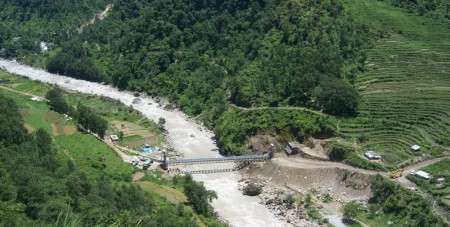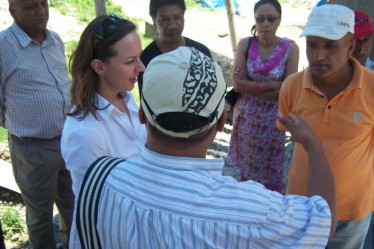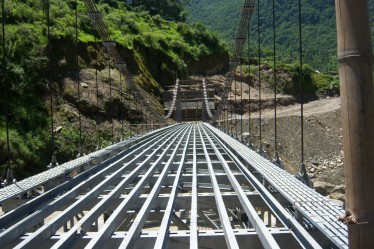I was born and brought up in Bristol, South West of the UK. In Bristol there is a famous bridge, the Clifton Suspension Bridge, which I learned at school was one of the first suspension bridges of its type in the world. It was completed in 1864 and spans 214 metres, connecting Clifton Downs (which was then outside the City of Bristol) with Leigh Woods. It has become an icon of Bristol.

Last week I went to see how suspension bridge technology is being used in Nepal to increase access for poor people to roads and services such as schools and health centres. I went to Dobilla in Parbat District, near Pokhara, to see a bridge which DFID had helped construct. Bridges are very much needed in Nepal, as there are many gorges and rivers – about 6,000 rivers and streams! - and much of the country is still far from accessible. It’s estimated that 70% of the population is not accessible by road, and there are parts of the country where it can still take someone 13 days to walk to the nearest road! So while in many other countries DFID no longer builds roads and bridges, here in Nepal we do and it’s making a big difference.

The technology used for this bridge costs approximately half in comparison to the previously used technology and, like the Clifton Suspension Bridge in its time, is testing the boundaries of what can be achieved. The engineer I’m talking to here explained that they learned a lot while building this bridge, using all Nepali materials (except cables, which came from India) and primarily local labour.

I was also told that the suspension bridge is most suitable for the hilly areas. Such bridges connect up to 150 metre wide rivers without any support in the middle and carry up to a 20 ton load. Harsh, glacial-fed river hydrology and unfavourable river bed materials make building multi-span bridges exceptionally difficult. (If you look closely, you can see it looks like a giant Meccano model, which can be relatively simply put together with minimum skill.) If they can demonstrate that this is replicable, it will mean that we can build more bridges more easily and cheaply across Nepal.

Work on the bridge generated about 18,000 person days of employment – with about 20 % of the workforce female. The woman pictured on the left worked on the bridge and was paid 180 Nepali rupees a day (about £1.40). I know this doesn’t sound like a lot, but the average labourer’s wage here is less than half of that – 75 Nepali rupees a day. I asked what the bridge would mean to her and she said that it meant she could now get to the nearest hospital in 15 minutes as opposed to 3 hours as previously. It also means that people are closer to markets and can get more money for their local produce than if they have to sell only locally. So in principle, the bridge should help boost the local economy too. An estimated 50,000 people will benefit from this bridge if you count the numbers of people in communities on both sides now connected by the road and bridge.
These kinds of bridges and trail bridges are dotted all over Nepal, particularly in the hill areas, and after a couple of months here, they are to me as part and parcel of Nepal as the Clifton Suspension Bridge is to Bristol.

15 comments
Comment by Sriram Yalamati posted on
Sarah,
I totally agree with your view that bridges would be an important aspect for development in Nepal. The entire country is so mountainous with so many gorges and valleys that travel from one place to another is just not easy. It must be so difficult to move men and materials from one place to another within the country.
Actually, let me relate my personal experience w.r.t. travel within Nepal. This was about 4 years back and we were on our way from Kathmandu to Pokhra. The only way to go to Pokhra was by flight ! And in the flight - you had a whole lot of locals transporting vegetables, goats, chicken, etc.! I suppose all locals would be forced to do that because that was the only mode of transport to Pokhra !
Anyway, All the best in your efforts.
Sriram
Comment by carol posted on
an interesting and informative article.
Comment by Preeti Sharma posted on
Very interesting write-up. Kudos to DFID for such a great initiative.
Comment by george waite posted on
Well done to all concerned. A useful bridge erected in difficult terrain.
I too was (like sarah) born in bristol and the clifton bridge was my first study subject.
George Waite
Bridge Engineer
Comment by zee posted on
Looks great. And clearly great social economic potential, if it is radically lowering travel/transport costs for communities nearby. What was your cost/benefit/ROI analysis b4 building? How and when will you evaluate the impact?
Sounds like you spent £25200 on labour (18000 days times £1.40). Can you tell us what the total cost of constructing the bridge was? And how long did it take? And it sounds like you paying twice the normal rate for labourers? Why, was it particularly skilled or difficult work? Do these higher costs impact on the future replication you want to do?
Sorry. You provided just enough detail to make me more curious. Thanks for blogging!!
Comment by Sarah Sanyahumbi posted on
Zee, I'm glad you found the blog interesting. You ask a lot of questions! I'll try to answer them here:
This bridge was originally planned and implemented by the government. The Department of Roads (DoR) and District Development Committees (DDCs) normally prioritise the communities’ demands rather than analyzing the benefit cost ratio. The DFID’s funds were used to mitigate the government’s funding shortfall. However, based on DFID’s similar analysis for other projects, the EIRR of such bridges exceeds 18% mainly because of the low cost construction technology. The annual average daily traffic of this bridge is 50 in the first year which is expected to reach 200 in 10 years time.
The Trail and Bridge Support Unit (TBSU) has undertaken a thorough baseline study prior to the construction. Further studies will be conducted on the technology used, bridge behavior, social impact as well as the ultimate cost-effectiveness.
The total construction cost is published locally on sign boards for the whole community to see. This ensures transparency and minimises corruption. It is as follows:
Wire Ropes NRs. 1,239,775
Civil Works 7,823,179
Insurance 40,000
Steel Parts 18,534,265
Total Amount 27,637,219 (about $354,000)
The linear cost ultimately amounted to NRs 300,000 ($3,800) per meter. This does not include cost for the technical assistance.
The bridge took 20 months to build.
The development projects pay according to the government determined rates where as the market rate could be slightly different. The discrepancy mainly occurred due to that. In addition to that the bridge construction is highly specialized task which requires bringing laborers from distant settlements and that involves more cost.
Notwithstanding higher labour costs, the overall construction cost is almost 50% of the traditional construction technology which is the sound basis for replication in a mass scale. The labour component is very small in terms of overall cost. On the other hand, the bridge project should have paid similar wage rate even they would have used the traditional technology.
I hope this helps!!
Comment by zee posted on
Thanks for humouring me with all that detail Sarah. It's all very impressive. You must have felt like you were writing a brief for PMQs not blogging! Thanks again.
Comment by Alem Shumiye posted on
Dear Sara,
My name is Alem Shumiye, I am responsible for the trail bridge programme of Helvetas in Ethiopia.
We have seen your observation regarding trail bridges programme in Nepal and would like to share you some of our experiences and lessons learnt from Nepal.
The situation in Ethiopia is also very similar to Nepal. Most of the population of Ethiopia lives away from motorable roads, travelling by foot on narrow trails, which often involve crossing rivers - small and large are quite common. Such risky crossings result in loss of human life and livestock particularly in rainy season. Longer travel time and risky crossings deter communities from going to socio-economic service centres. In response to expressed needs from communities and local authorities, a successful modest pilot project was launched in Ethiopia in 2003. As a result, it has been found that trail bridges are important complements to solve crossing problems of rural communities. Although the technology was new to the community and local authorities, the trail bridges constructed were highly welcomed by the users. Following the pilot project, Helvetas Ethiopia received demands for such bridges from communities and local authorities.
Helvetas Ethiopia has created contacts to Helvetas Nepal, DFID and SDC supported bridge programmes in Nepal. Such contacts have helped to realize the transfer of trail bridge know to Ethiopia. In this regard, the collaboration has assisted to realize a meaningful cooperation between Helvetas Nepal and Helvetas Ethiopia under the theme of “south-south collaboration”. Some of these instances include, in December 2007, a team consisting of Helvetas Ethiopia and ERA visited Nepal and learnt about trail bridge programme management. In March 2008 a planning team consisting of Helvetas Nepal supported Helvetas Ethiopia on elaborating “Establishing Trail Bridge Programme in Ethiopia”. In November–December 2008, 14 Ethiopian personnel (engineers, social workers, project manager) could be trained on “Capacity Building Training on Trail Bridges” in Nepal.
Following high local demand for the technology, Helvetas Ethiopia initiated a nationwide trail bridge programme. To this effect a cooperation agreement has been signed in May 2008 between Ethiopian Government (Ethiopian Roads Authority) and Helvetas Ethiopia. A ProDoc is approved with the start-up phase covering 1.5 years (January 2009 to June 2010). Lessons learnt from the first phase will lead to a larger programme scope in the years following 2010. In principle, the programme will be implemented in all Regions of the country; however, the first phase will focus in four Regions (Amhara, Tigray, Gambella, and SNNPR). Emphasis during the start-up phase will be on the construction of 12 bridges in tandem building of local capacities and adaptation of relevant manuals. Trail Bridge Programme is integrated within the Ethiopian Rural Transport and Travel Programme (ERTTP). DFID Ethiopia is the major partner of nationwide project. DFID Ethiopia, through ERTTP, will cover a portion of local road agencies’ contribution amounting to 56% of the total project outlay. Helvetas Ethiopia will finance the remaining investment balance.
In general, Helvetas Ethiopia appreciates the support that has been provided from Helvetas Nepal, SDC Nepal, DFID Nepal and Ethiopia towards realizing a successful trail bridge programme in Ethiopia. We are optimistic that such collaboration will be further strengthened in the years ahead.
Best regards,
Alem Shumiye
Trail Bridge Project Manager
Helvetas Ethiopia
Comment by Artha Tuladhar posted on
Dear Sarah,
Being involved in the pedestrian trail bridge sector for the last two decades (first as project staff and later as research consultant for Helvetas Nepal), I took immense satisfaction when DFID began supporting this vital infrastructure program aimed at improving the livelihood of people living in inaccessible corners of Nepal.
I did a number of research studies for Helvetas Nepal that helped to formulate pro-people programs and policies in this sector. As such, Helvetas entrusted me to author Helvetas Publication No. 5: Experience and Learning in International Co-operation - Trail Bridge Building in the Himalayas focusing on the co-operation in Nepal and Bhutan (perhaps you have a copy too).
By any count Nepal still needs hundreds upon hundreds of short and long span trail bridges not just along foot trails but also to link the so called 'agricultural' tracks and roads over numerous river crossings. For rapid development of the Nepalese hinterlands as well as the terai, commensurate with the aspirations, expectations of the people, as the major donor partner in this sector, I believe, DFID ought to take a new fresh look at the type of suspension bridge and the processes and procedures involved in building them.
Thank you.
Artha Tuladhar
2009.09.15
Comment by Sarah Sanyahumbi posted on
Dear Artha,
Many thanks for your response and I am also happy to know that you contributed to this very important area.
As you indicated correctly that DFID has remained vigilent in terms of construction technology, process and procedures. The GoN's trail bridge unit replicated the trail bridge technology for the motorable bridges with our support. Similarly all donor and government partners are also considering to undertake another action research on appropriate pedestrian and motorable suspension bridges for Terai. I assure you that this process will continue in future as well. But I wonder if you have something very specific in your mind.
Sarah
Comment by Narendra posted on
Hi Sarah,
Kudos to you and your team!
Nepal needs goodwill efforts and infrastructure building support for Nepali to have basic access to this beautiful and wonderful world.
Nepal is rich in natural beauty. The people are nice and honest. They need supports to come up in life.
Regards
Narendra
Comment by Lok Bhattarai posted on
Dear Sarah
I thank you for your interest and your valued judgements on the importance of the bridges in Nepal. I do also appreciate DFID Nepal for its unique approach in project selection and funding.
For over several years, I am here in the UK. While I am here, I am trying to study the UK's history of development, approaches and visions behind it, and also about people-place relationship.
The great thing, I think everyone does notice in the UK is the planned development of residential area which is not a case in the developing countries like in Nepal. In Nepal, there has never been an effective land-use planning meaning that people could choose to build their house wherever they want. Consequently, we can see a huge dispersal of settlements all over making any effective modern planning almost unlikely. There are hundred and one factors- historical, social, cultural and economic which are responsible for making this a reality. But, saying so, I don't mean that there is no hope. A unique, original, locally-based approach could help make things better. Example of the trail-bridge is one amongst the other as you shared here above. Such projects are sustainable, render no or little environmental impact, involve little operation and maintenance cost with huge benefit distribution and being it equally accessible to everyone that is what we need to think about.
I have damn negative impression and experience of the kinds of development projects which do not or if it does do carry only little of such characteristics and scope.
I would suggest DFID Nepal to keep up with such an approach in funding decision-making and making development support people-friendly.
Lok Bhattarai
now in the UK
Comment by Sanjay Das posted on
Dear Sarah,
I was brought up in Nepal and took up Bridge Engineering as my career right from when I was student at Budhanilkantha School in Kathmandu progressing onto Cambridge University, and finally following into working as a Bridge Engineer for almost 10 years now in the UK. I studied Bridge Engineering to work in Nepal but unfortunately could not get the right opportunity to serve. I deeply believe, bridges have transformed civilisations and so will do for Nepal. I am glad that DFID has recognised this.
Comment by Gaya Prasad Ulak posted on
Dear Sarah,
This bridge is an initiative towards the enhancement of local technical person capacity in Nepal after Marsyangdi Jeepable bridge in Tanahu about 100m span with the same technology. The UK Aid is limited in this bridge, but it is an innovative in mountaineous country like Nepal. Such type of work is not replicated by the donor supported projects in Nepal during these years. I would like to the efforts of TBSU/Helvetas experts ( Dr. Joshi and Mr. Rajbhandari) in Nepal to construct the bridge in time to complete the bridge. Only using same traditional technology is preferred by the design engineers in Nepal. There are limited grants in bridge building in Nepal till to date in comparision to construction of fair weathered roads. From last years there are a huge demand of road bridges in feeder roads and rural roads in Nepal. It is difficult to construct those bridges in the same technology. So as an enginneer working in the rural bridge sector since 2004 and participated from the government agecy in the above bridge I would like to request all the donors to promote cable suspension bridges in hilly zone and precast and arch bridges constrution in general topography (plain) zone providing technical assitance for constrution through government agencies and technology transfer through private engineering colleges in Nepal and donor countries with internship for graduate engineers exchange programme, to build new Nepal for the new generation giving more opportunities in Nepal in the comming days from UKAid.
Comment by raj adhikari posted on
well done